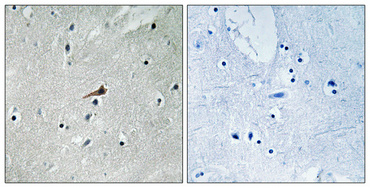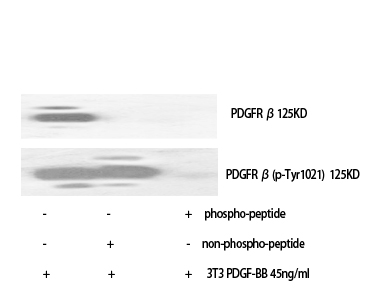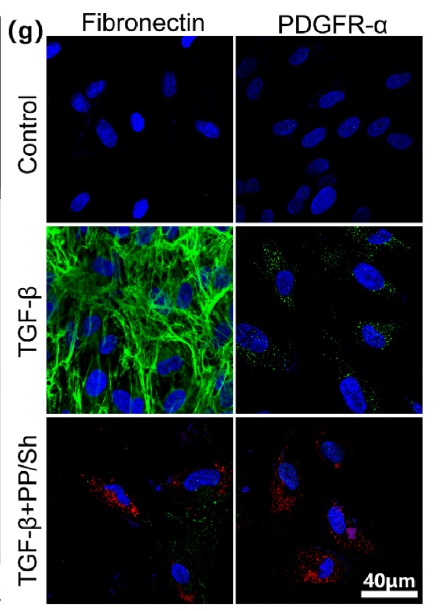Total PDGFRβ Cell-Based Colorimetric ELISA Kit
- Catalog No.:KA4226C
- Applications:ELISA
- Reactivity:Human;Mouse;Rat
- Gene Name:
- PDGFRB
- Human Gene Id:
- 5159
- Human Swiss Prot No:
- P09619
- Mouse Swiss Prot No:
- P05622
- Rat Swiss Prot No:
- Q05030
- Storage Stability:
- 2-8°C/6 months
- Other Name:
- Platelet-derived growth factor receptor beta (PDGF-R-beta) (PDGFR-beta) (EC 2.7.10.1) (Beta platelet-derived growth factor receptor) (Beta-type platelet-derived growth factor receptor) (CD140 antigen-like family member B) (Platelet-derived growth factor receptor 1) (PDGFR-1) (CD antigen CD140b)
- Detection Method:
- Colorimetric
- Background:
- catalytic activity:ATP + a [protein]-L-tyrosine = ADP + a [protein]-L-tyrosine phosphate.,disease:A chromosomal aberration involving PDGFRB is a cause in many instances of chronic myeloproliferative disorder with eosinophilia (MPE) [MIM:131440]. Translocation t(5;12) with ETV6 on chromosome 12 creating an PDGFRB-ETV6 fusion protein.,disease:A chromosomal aberration involving PDGFRB is found in a form of chronic myelomonocytic leukemia (CMML). Translocation t(5;12)(q33;p13) with EVT6/TEL. It is characterized by abnormal clonal myeloid proliferation and by progression to acute myelogenous leukemia (AML).,disease:A chromosomal aberration involving PDGFRB may be a cause of acute myelogenous leukemia. Translocation t(5;14)(q33;q32) with TRIP11. The fusion protein may be involved in clonal evolution of leukemia and eosinophilia.,disease:A chromosomal aberration involving PDGFRB may be a cause of juvenile myelomonocytic leukemia. Translocation t(5;17)(q33;p11.2) with SPECC1.,disease:A chromosomal aberration involving PDGFRB may be the cause of a myeloproliferative disorder (MBD) associated with eosinophilia. Translocation t(1;5)(q23;q33) that forms a PDE4DIP-PDGFRB fusion protein.,function:Receptor that binds specifically to PDGFB and PDGFD and has a tyrosine-protein kinase activity. Phosphorylates Tyr residues at the C-terminus of PTPN11 creating a binding site for the SH2 domain of GRB2.,similarity:Belongs to the protein kinase superfamily. Tyr protein kinase family.,similarity:Belongs to the protein kinase superfamily. Tyr protein kinase family. CSF-1/PDGF receptor subfamily.,similarity:Contains 1 protein kinase domain.,similarity:Contains 5 Ig-like C2-type (immunoglobulin-like) domains.,subunit:Homodimer, and heterodimer with PDGFRA. Interacts with APS. The autophosphorylated form interacts directly with SHB and with PIK3C2B, maybe indirectly.,
- Function:
- skeletal system development, urogenital system development, in utero embryonic development, kidney development,tissue homeostasis, regulation of protein amino acid phosphorylation, protein amino acid phosphorylation,phosphorus metabolic process, phosphate metabolic process, cell motion, chemotaxis, cell surface receptor linked signal transduction, enzyme linked receptor protein signaling pathway, transmembrane receptor protein tyrosine kinase signaling pathway, muscle organ development, behavior, locomotory behavior, positive regulation of cell proliferation, embryonic development ending in birth or egg hatching, phosphorylation, cell migration, peptidyl-tyrosine phosphorylation, peptidyl-tyrosine modification, regulation of phosphate metabolic process, regulation of cell migration, positive regulation of cell migration, regulation of protein modification process, regulation of cellular
- Subcellular Location:
- Cell membrane; Single-pass type I membrane protein. Cytoplasmic vesicle. Lysosome lumen. After ligand binding, the autophosphorylated receptor is ubiquitinated and internalized, leading to its degradation.
- June 19-2018
- WESTERN IMMUNOBLOTTING PROTOCOL
- June 19-2018
- IMMUNOHISTOCHEMISTRY-PARAFFIN PROTOCOL
- June 19-2018
- IMMUNOFLUORESCENCE PROTOCOL
- September 08-2020
- FLOW-CYTOMEYRT-PROTOCOL
- May 20-2022
- Cell-Based ELISA│解您多样本WB检测之困扰
- July 13-2018
- CELL-BASED-ELISA-PROTOCOL-FOR-ACETYL-PROTEIN
- July 13-2018
- CELL-BASED-ELISA-PROTOCOL-FOR-PHOSPHO-PROTEIN
- July 13-2018
- Antibody-FAQs



